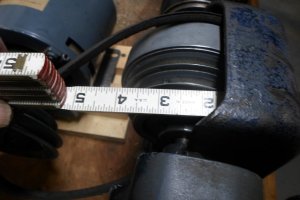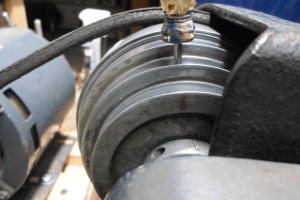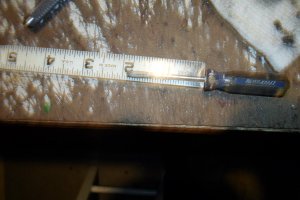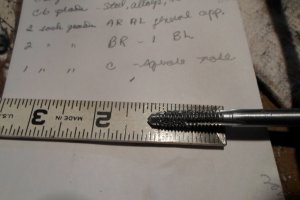working on the Sears 109 mini lathe. Has been worked on before, using the term loosely. Had parts missing in the head stock drum for the back gear assembly that lowers the rpm 5:1. Got that piece made and it works good. Putting in back together I could not lock the driven 2 step pulley to the shaft. Found out the set screw did not come close to going to the shaft. Tapped hole is in the center of the 3" middle pulley. Tried to run a tap down but tap was short of going through. Found the bushings, one from each side of the pulley, had been replaced and the one bushing had been pressed in to far and had the hole for the set screw half covered. Aluminum pulley so trying to drill the bushing out would only eat out the aluminum pulley. A small screwdriver blade will just go past the end of the bushing far enough to touch the shaft. Set screw is 1/4 X 20 so can make a longer set screw but the problem is to get the bottom end opened up enough to allow the set screw to anchor to the shaft. Any suggestions ? ?
You are using an out of date browser. It may not display this or other websites correctly.
You should upgrade or use an alternative browser.
You should upgrade or use an alternative browser.
Ran Into A Snag Today
- Thread starter chieffan
- Start date
Can't you press them back?Found the bushings, one from each side of the pulley, had been replaced and the one bushing had been pressed in to far and had the hole for the set screw half covered.
If you have a vertical mill or even a good drill press you could drill through the bushing with an end mill bit to allow a longer set screw to get to the shaft. The other option is using a Dremel tool with a 1/8" burring bit to clean up the one half of the bushing covering the hole
If you have a vertical mill or even a good drill press you could drill through the bushing with an end mill bit to allow a longer set screw to get to the shaft. The other option is using a Dremel tool with a 1/8" burring bit to clean up the one half of the bushing covering the hole
Have a good drill press but no end mill or milling machine. Over 1.5" from the pulley flange to the center. No way a dremel would come close to reaching it.
Ever heard of a gun barrel drill bit? They won't take anything off the side of the hole.
Sure have but don't have one of them either. Those puppies are not cheep either and I can still buy wholesale from Brownells, Inc.
Bushing is hard brass. I tried to move it with a brass punch but the nicked the corner of the punch. Going to try and come in through the bushing and take a corner off when the set screw is to be with a Dremel and round burr. Looks like about 5/8" long bushings so should be able to reach it.
Appreciate the ideas guy. Lot of you have had a ton more experience at machining that I have. My first lathe to play around with and learn something, - maybe.
Is the tap long enough so you can put the female end of a 1/4" extension on it? If not then sacrifice the tap and weld a piece of 1/4" round stock to it and get out the vise grips. Just preheat the tap first and let it cool slowly. Might even work better to braze the two together. Since your tapping thru brass overheating tap won't matter.
Mike
Mike
Is the tap long enough so you can put the female end of a 1/4" extension on it? If not then sacrifice the tap and weld a piece of 1/4" round stock to it and get out the vise grips. Just preheat the tap first and let it cool slowly. Might even work better to braze the two together. Since your tapping thru brass overheating tap won't matter.
Mike
The shank of the tap hits the bottom of the pulley grove and the threading portion is into the hole. This is a 3/8" belt pulley so narrower than most. It is the threading portion of the tap that is not long enough. Going to try andnotch the edge of the bushing out with a dremel tool today and see what shakes out. Will try and remember to get some photos today.
I'll await the photos before commenting further.
Mike
Mike
Used a ball bur and got the corner of the bushing cut away enough for the allen screw to seat against the shaft. All back together and so far so good.

This shows the center pulley to be right at 3.5" ± Uses a 3/8" belt. A 1/2" will not work.

Screwdriver in the allen hole on top of the 3/8" long allen screw.

Screwdriver shank is right at 2" long.

Tap will only cut full threads about 1-3/8" before the shanks contacts the pulley.
This machine was built by Ann Arbor Mfg. for sears up until the mid 1960's so it has been around for a while.
The planetary gear system is inside the drum near the top of the first photo. Quite a design the way the different speed can be achieved using the two step pulleys plus the 5:1 reduction of the planetary gearing.
Thanks much for the suggestions. The ball bur worked good to take the inside corner off the bushing. Now to get the various speed combinations recorded so I know which pulleys to use for the speed I need.

This shows the center pulley to be right at 3.5" ± Uses a 3/8" belt. A 1/2" will not work.

Screwdriver in the allen hole on top of the 3/8" long allen screw.

Screwdriver shank is right at 2" long.

Tap will only cut full threads about 1-3/8" before the shanks contacts the pulley.
This machine was built by Ann Arbor Mfg. for sears up until the mid 1960's so it has been around for a while.
The planetary gear system is inside the drum near the top of the first photo. Quite a design the way the different speed can be achieved using the two step pulleys plus the 5:1 reduction of the planetary gearing.
Thanks much for the suggestions. The ball bur worked good to take the inside corner off the bushing. Now to get the various speed combinations recorded so I know which pulleys to use for the speed I need.
Glad ya got things back to rights !!
Mike
Mike
With the help from you guys I got to thinking in the right direction.Glad ya got things back to rights !!
Mike
